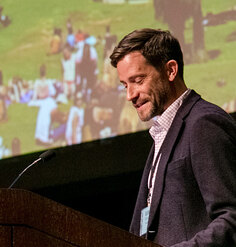The Environmental/Social Crisis and the Challenges of Informal Urbanization
By David Gouverneur
This presentation was part of the Landscape Architecture Foundation’s The New Landscape Declaration: A Summit on Landscape Architecture and the Future held in Philadelphia on June 10-11, 2016. LAF asked a diverse group of leading minds to write a “Declaration” reflecting on the last half century and offering bold ideas for how landscape architecture can make its vital contribution in response to the challenges of our time.
David Gouverneur
Associate Professor of Practice, Department of Landscape Architecture, University of Pennsylvania
Professor Emeritus, Universidad Rafael Urdaneta, Maracaibo, Venezuela
Philadelphia, Pennsylvania
David Gouverneur is associate professor of practice in the Department of Landscape Architecture at the University of Pennsylvania School of Design. He is also professor emeritus of Universidad Rafael Urdaneta in Maracaibo, Venezuela. Gouverneur received his architecture degree from Universidad Simón Bolívar, Caracas, and his master of architecture in urban design from Harvard Graduate School of Design.
*Affiliation at the time of the Summit
The Environmental/Social Crisis and the Challenges of Informal Urbanization
By David Gouverneur
If we want to have a better life, our neighbors must live better also.
—Oscar Grauer
The disparities between the haves and have-nots are growing in technically advanced nations, while the gap separating these countries from the developing world is widening.
Politically unstable, war-torn areas of the Global South often lose people migrating to the developed world. Urban inequality results in increased levels of social resentment and violence. These are perhaps just early indicators of what the future may bring. Such conditions will worsen as a consequence of climate change, water and food shortages, and the growing disparities in access to infrastructure, services, new technologies, information, and appropriate governance.
This bleak forecast and the depletion of the planet’s resources are closely tied to urbanization at exponential levels, much of which will take place in developing countries where some of largest urban agglomerations in history already exist. A high percentage of this growth will occur in the form of informal settlements.
In the early twentieth century, modern city planning was globally recognized as a tool to manage rapid urbanization. Planning emphasized the functional and quantitative, ignoring cultural and environmental nuances. Zoning was introduced to regulate land uses, correlated with mobility and infrastructure systems and services. An unintended consequence was the expansion and fragmentation of once compact cities. Additionally, it became a tool for social segregation.
In the developing world, where a high percentage of the population could not participate in the real-estate-driven model, planning unintentionally pushed out the poor from the areas designated for urban expansion. Settlements occupied peripheral sites unfit for urbanization: unstable land, floodplains, and areas next to landfills, under high-power lines, or in environmentally sensitive and protected areas.
While the informal city evolved with great dynamism, presenting strong social ties, encompassing informal economies, and producing compelling organic forms, it did so without the basic advantages of urban living. Informal cities have limited accessibility and mobility, endure unsanitary conditions, and lack public space and services, resulting in urban areas that are incomplete and submissive to the formal city. As informal areas become larger, inequality increases and city performance falls behind.
After decades of informal settlements being ignored, eradicated (only to reappear someplace else), and targeted by housing programs with limited coverage, informality became the dominant form of urbanization, and creative planning and design approaches emerged to improve existing informal areas. Latin America was at the vanguard of such trends. In 2014, for example, the World Urban Forum was held in the one-time murder capital of the world—Medellín, Colombia—which proudly demonstrated how their interventions reduced levels of violence and social inequities and improved overall city performance.
These trends are now being emulated in many developing countries; however, these successful urban interventions are laborious and have limitations. Such changes are efficient at a neighborhood scale, but they cannot address larger, more complex urban areas. In addition, an estimated one billion people will live in new informal settlements over the next two decades. Even in countries where the government proactively deals with informality, officials are skeptical of planning ahead for new informal areas. Officials are unable to deter the informal areas and allow them to spring up, thinking that perhaps in the future they can address resulting problems with settlement improvement projects.
A paradigm shift is urgently required. In Planning and Design for Future Informal Settlements: Shaping the Self-Constructed City (Gouverneur 2014), I suggest how such challenges may be handled. The proposal is simple but entails a different mindset as well as new design and managerial criteria, which I have referred to as the informal armatures approach (IAA).
IAA suggests that emerging informal areas, properly assisted, can evolve into balanced and attractive urban areas, perhaps surpassing the performance of formal cities. It is possible to combine the vibrancy, flexibility, organic morphology, sense of place, and communal engagement of informality with the benefits of cutting edge planning and design. This preemptive and ongoing method may nurture a hybrid product (formal/informal), operating at different scales (from the site specific to the territorial), and resulting in a rich urban ecology, in constant transformation, while increasing resiliency.
For IAA to succeed, certain conditions should be met. There must be acceptance that inaction will result in a high price for social and environmental stress, which requires acknowledging that informality is a valid form of city making and that we must embrace it with creative ways of influencing it. Proactive land-banking policies must be employed to reduce the exclusionary effects of the real-estate-driven model to attain, over time, more balanced urban organizations. Planning, design, and managerial efforts must focus only on what communities cannot address alone, with a physical and nonphysical system that will support rapid change by addressing the public realm, the delivery of services, and how these transform over time; providing patches where self-construction is suitable; and gradually incorporating urban components that usually only exist in the formal city. And alliances must be formed among the political sector, the professional milieu, the private sector, and communities, with strong leadership and qualified facilitators who can work on-site with cross-disciplinary teams and residents.
In contrast to conventional planning, this approach enhances the environmental, the social, and the performance features, delving into aspects that are relevant to each context, envisioning a compelling, flexible, and transformative public realm.
These supporting armatures may bundle different components: low-cost mobility, water management, food production, access to education, local manufacturing skills, reduction of violence, enhanced self-governance, etc. For the most part, communities will do what they know best: they will construct their own homes, develop strong social ties, and incorporate income generating activities.
IAA can be considered a landscape urbanism method that can better assist the emerging informal city. While these ideas are particularly helpful to the developing world, the basic criteria—addressing efficacy, creating added value, managing constant transformations, and fostering resiliency—may be applicable in any context.











